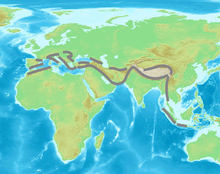Cenozoic era
| Eon | It was | Millions of years |
|---|---|---|
| Fanerozoic | Cenozoico | 66 |
| Mesozoic | 251.0 ±0.4 | |
| Paleozoic | 542,0 ±1,0 | |
| Proterozoic | 2500 | |
| Arcaico | 3800 | |
| Hádico | ca. 4570 |
The Cenozoic Era or Cenozoic (formerly also Tertiary Era), a division of the geologic time scale, is the geologic era that began It began about 66 million years ago and extends to the present. It is the third and last era of the Phanerozoic eon and follows the Mesozoic era. Its name comes from the Greek language and means "new animals" (from καινός/kainos, "new" and ζωή/zoe, "animal or life"). The tertiary period, currently not recognized by the International Commission on Stratigraphy, included the Cenozoic era except for the last 2.5 million years, when the Quaternary period begins.
During the Cenozoic era, India collided with Asia 55-45 million years ago, and Arabia collided with Eurasia, closing off the Tethys Sea, about 35 million years ago. As a consequence of this, the great alpine folding occurs that formed the main mountain ranges of southern Europe and Asia, such as the Pyrenees, Alps and Himalayas.
The Cenozoic is also called the era of mammals, animals that, when the dinosaurs became extinct at the end of the Cretaceous, underwent extraordinary adaptive radiation and became the characteristic and dominant fauna. About 30 million years ago the first higher primates arose (the most primitive were already present more than 65 million years ago), although Homo sapiens did not appear until about 300,000 years ago.
Subdivisions
The Cenozoic is divided into three periods: Paleogene, Neogene and Quaternary; which in turn are divided into periods. The Paleogene comprises the Paleocene, Eocene and Oligocene epochs, the Neogene comprises the Miocene, Pliocene, while the Quaternary comprises the Pleistocene and Holocene epochs, the latter of which is currently ongoing. The Old Tertiary period comprised the Paleogene and Neogene.
Tectonics
Geologically, the Cenozoic is the time when the continents moved to their present positions. Australia-New Guinea broke away from Gondwana and drifted north and approached Southeast Asia. Antarctica moved to its present location over the South Pole. The Atlantic Ocean widened, and later, South America joined North America with the formation of the Isthmus of Panama.
India collided with Asia 55-45 million years ago, beginning with the formation of the Himalayas. At the same time, Arabia collided with Eurasia, closing off the Tethys Sea around 35 million years ago. As a consequence, the Alpine Orogeny occurred, which formed the major mountain ranges of southern Europe and Asia, beginning in the Atlantic, passing through the Mediterranean and the Himalayas and ending on the islands of Java and Sumatra. Specifically, they were formed from west to east: Atlas, Betic Cordilleras, Sierra Nevada (Spain), Pyrenees, Alps, Dinaric Alps, Pindos, Balkans, Taurus Mountains, Caucasus, Elburz Mountains, Zagros, Hindu Kush, Pamir Mountains, Karakórum and Himalayas. Currently, the process is still ongoing in some areas.[citation needed]
Climate
The Cenozoic has been a period of long-term cooling. Early in the Cenozoic, particles ejected from the K/T boundary impact blocked solar radiation. After the tectonic creation of the Drake Passage, when Australia completely separated from Antarctica during the Oligocene, the climate cooled considerably due to the emergence of the Antarctic Circumpolar Current which caused a great cooling of the Southern Ocean.
In the Miocene there was a slight warming due to the release of hydrates that gave off carbon dioxide. When South America was joined to North America by the creation of the Isthmus of Panama, the Arctic region cooled due to the strengthening of the Peru Current and Gulf Current, leading to the last glacial maximum.
Biology
At the end of the Cretaceous period, the Cretaceous-Tertiary mass extinction occurred, which included the dinosaurs and the vast majority of living species. The theory most accepted by scientists points to the impact of a gigantic meteorite as the trigger. The great explosion generated in its impact would have raised large amounts of dust into the air, preventing sunlight from reaching the plants, reducing their quantity and thereby generating an imbalance in the food chain (plant - herbivore - carnivore); as a result, 75% of life on Earth became extinct. The disappearance of the great reptiles gave way to the Cenozoic. Currently, it is suspected that the emission of toxic gases due to the volcanism of the Deccan Traps in India may have also contributed to this extinction.
During this era, mammals, taking advantage of the void left by the lizards and dinosaurs, multiplied and diversified, imposing their dominance over the rest of the vertebrates. Of the 10 families that existed at the beginning of the first epoch of the Cenozoic, the Paleocene, there were almost 80 in the Eocene —after only 10 million years of evolution. Many families of modern mammals, for their part, date from the Oligocene —that is, between 35 and 24 million years ago— and it was in the Miocene —between 24 and 5 million years ago— when the greatest diversity of species was recorded.. In this last period, the first and most primitive Hominoidea appeared, such as Proconsul, Dryopithecus and Ramapithecus. From the Miocene the number of mammals began to decline and, as a consequence of the profound climatic changes that occurred during the Pliocene, about 2 million years ago, many species disappeared. At that time, the Ice Age was about to begin —within the Pleistocene— in which a highly advanced primate was going to impose its reign: the genus Homo .
Contenido relacionado
Geology of the Falkland Islands
Popocatepetl
Esker


